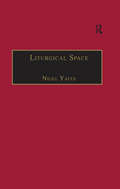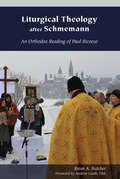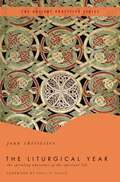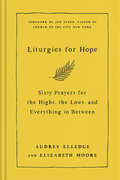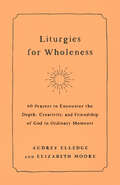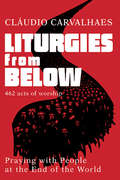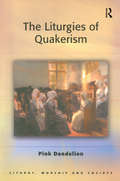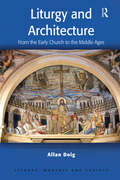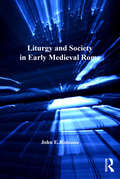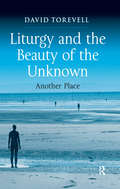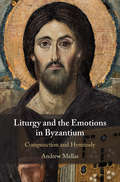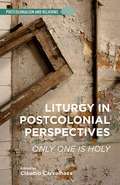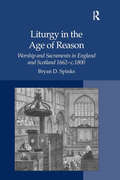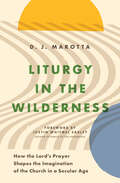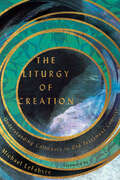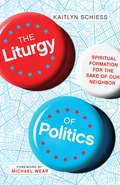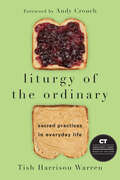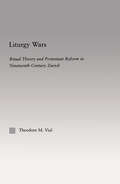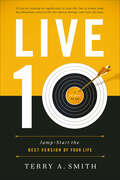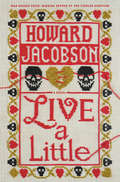- Table View
- List View
Liturgical Space: Christian Worship and Church Buildings in Western Europe 1500-2000 (Liturgy, Worship and Society Series)
by Nigel YatesThis is the first comprehensive and up-to-date account of the internal arrangement of church buildings in Western Europe between 1500 and 2000, showing how these arrangements have met the liturgical needs of their respective denominations, Catholic and Protestant, over this period. In addition to a chapter looking at the general impact of the Reformation on church buildings, there are separate chapters on the churches of the Lutheran, Reformed, Anglican and Roman Catholic traditions between the mid-sixteenth and mid-nineteenth centuries, and on the ecclesiological movement of the nineteenth century and the liturgical movement of the twentieth century, both of which have impacted on all the churches of Western Europe over the past 150 years. The book is extensively illustrated with figures in the text and a series of plates and also contains comprehensive guides to both further reading and buildings to visit throughout Western Europe.
Liturgical Theology after Schmemann: An Orthodox Reading of Paul Ricoeur (Orthodox Christianity and Contemporary Thought)
by Brian A. Butcher Fba Andrew LouthWhile only rarely reflecting explicitly on liturgy, French philosopher Paul Ricoeur (1913-2005) gave sustained attention to several themes pertinent to the interpretation of worship, including metaphor, narrative, subjectivity, and memory. Inspired by his well-known aphorism, “The symbol gives rise to thought,” Liturgical Theology after Schmemann offers an original exploration of the symbolic world of the Byzantine Rite , culminating in a Ricoeurian analysis of its Theophany “Great Blessing of Water.” . The book examines two fundamental questions: 1) what are the implications of the philosopher’s oeuvre for liturgical theology at large? And 2)how does the adoption of a Ricoeurian hermeneutic shape the study of a particular rite? Taking the seminal legacy of Orthodox theologian Alexander Schmemann (1921-1983) as its point of departure, Butcher contributes to the renewal of contemporary Eastern Christian thought and ritual practice by engaging a spectrum of current theological and philosophical conversations.
The Liturgical Year: The Spiraling Adventure of the Spiritual Life - The Ancient Practices Series
by Joan ChittisterA journey of the soul through the map of Christian time.The liturgical year, beginning on the first Sunday of Advent and carrying through the following November is the year that sets out to attune the life of the Christian to the life of Jesus, the Christ. This book sets out to open what may at first seem to be simply an arbitrary arrangement of ancient holy days or liturgical seasons to their essential relationship to one another and their ongoing meaning to us today. It is an excursion into life from the Christian perspective, from the viewpoint of those who set out not only to follow Jesus but to live as Jesus lived and to think as Jesus thought.It proposes, year after year, to immerse us over and over again into the sense and substance of the Christian life until, eventually, we become what we say we are-followers of Jesus all the way to the heart of God. It is an adventure in human growth; it is an exercise in spiritual ripening.
Liturgies for Hope: Sixty Prayers for the Highs, the Lows, and Everything in Between
by Audrey Elledge Elizabeth MooreSixty contemporary, comforting liturgies that break through the noise of modern life to offer time-tested wisdom for readers navigating burnout, anxiety, and other stresses.&“Beautiful words to help us access the longings of our souls and bring them to God. If you&’re looking for a jumpstart to your spiritual life, start here.&”—Rich Villodas, lead pastor of New Life Fellowship and author of Good and Beautiful and KindRemind us, Jesus, that You lay sleeping in the boat, in the middle of the storm at sea. You are neither surprised nor distressed by the mounting chaos. You are not a God who panics.When writers Audrey Elledge and Elizabeth Moore were inspired to create an anchor of hope for their own local community, they moved forward by turning to the past, to a time when Christians looked at the collapsing world around them and resolved to offer something beautiful—something true—through poetic prayers. The stunning result is Liturgies for Hope, an original collection of modern liturgies reminiscent of past generations of faith. Designed to awaken your prayer life, the entries in this gentle guide explore experiences such as• feeling burned-out and soul-weary• embracing the mystery of faith• receiving the kindness of others• struggling with secret shame• bursting with thanksgivingWith Scripture references for every prayer, Liturgies for Hope is both timeless and ideal for this moment, offering words to express our longings, shore up our prayers, and reorient our souls.
Liturgies for Wholeness: 60 Prayers to Encounter the Depth, Creativity, and Friendship of God in Ordinary Moments
by Audrey Elledge Elizabeth MooreSixty modern and inspiring liturgies that offer compassionate insight to nurture your soul, from the bestselling authors of Liturgies for Hope.&“A voice of reassurance and a much needed reminder of the hope we have.&”—Joshua Luke Smith, performing artist, pastor, and authorWhat if my current life is preparing me for something I can&’t see? Oh God, when I feel overlooked and forgotten,when I ache to be important,redirect my heart to You who remembers me. When your spirit is restless and you can&’t find the words, these modern-day liturgies help you articulate your brokenness to the God who calls you beloved.The lyrical prayers in Liturgies for Wholeness name our longings—the ache for physical rest, the grief over something we never had, the desire for healing in a relationship—even as they call us to notice the blessing of washing our face and watching nightfall and sink deep into an awareness of God&’s presence.Divided into eight sections—including Mind, Senses, Body, Home, and Community—these liturgies can be read communally or individually to bring you into greater intimacy with God. Each prayer includes related Scripture references to offer you further opportunity for meditation and reflection.With each liturgy in Liturgies for Wholeness, may you sense God&’s deep desire for you and may you delight in the only One who can make you whole.
Liturgies from Below - UK Edition: Praying with People at the Ends of the World
by Claudio CarvalhaesIt’s been said that prayer is the vocabulary of faith. This book offers a wealth of resources from forgotten places to help us create a new vocabulary for worship and prayer, one that is located amidst the poor and the major issues of violence and destruction around the world today. It is a collection of prayers, songs, rituals, rites of healing, Eucharistic and baptismal prayers, meditations and art from four continents: Asia-Pacific Islands, Africa, Americas, and Europe. Liturgies from Below is the culmination of a project organized by the Council for World Mission (CWM) during 2018-2019. Approximately 100 people from four continents worked with CWM, collaborating to create indigenous prayers and liturgies expressing their own contexts, for sharing with their communities and the rest of the world. The project was called "Re-Imagining Worship as Acts of Defiance and Alternatives in the Context of Empire". The author and others spent weeks living in each of four communities for several weeks/months, getting to know the people, and then facilitating the people’s own creation of prayers and liturgies. The author, other scholars, pastors, artists, activists and students all came from radically different ethnicities, races, sexualities, churches and Christian theologies. The people in each location were poor, living in very challenging communities, living in oppressive and seemingly hopeless situations. After some time, they wrote prayers and stories of their experience trying to live the Christian faith in utterly abandoned places. What we have here is an immensely rich and varied collection of liturgical sources from various communities dealing with issues of violence, immigration/refugees, drugs, land grabbing, war on the poor, attack on women, militarization, climate change, and so on.
The Liturgies of Quakerism (Liturgy, Worship and Society Series)
by Pink DandelionThe Liturgies of Quakerism explores the nature of liturgy within a form of worship based in silence. Tracing the original seventeenth century Quakers' understanding of the 'liturgy of silence', and what for them replaced the outward forms used in other parts of Christianity, this book explains how early Quaker understandings of 'time', 'history', and 'apocalyptic' led to an inward liturgical form. The practices and understanding of twenty-first century Liberal Quakers are explored, showing that these contemporary Quakers maintain the same kind of liturgical form as their ancestors and yet understand it in a very different way. Breaking new ground in the study of Quaker liturgy, this book contrasts the two periods and looks at some of the consequences for the study of liturgy in general, and Quakerism in particular. It also explores evangelical Quaker understandings of liturgy.
Liturgy and Architecture: From the Early Church to the Middle Ages (Liturgy, Worship and Society Series)
by Allan DoigIn this book Allan Doig explores the interrelationship of liturgy and architecture from the Early Church to the close of the Middle Ages, taking into account social, economic, technical, theological and artistic factors. These are crucial to a proper understanding of ecclesiastical architecture of all periods, and together their study illuminates the study of liturgy. Buildings and their archaeology are standing indices of human activity, and the whole matrix of meaning they present is highly revealing of the larger meaning of ritual performance within, and movement through, their space. The excavation of the mid-third-century church at Dura Europos in the Syrian desert, the grandeur of Constantine's Imperial basilicas, the influence of the great pilgrimage sites, and the marvels of soaring Gothic cathedrals, all come alive in a new way when the space is animated by the liturgy for which they were built. Reviewing the most recent research in the area, and moving the debate forward, this study will be useful to liturgists, clergy, theologians, art and architectural historians, and those interested in the conservation of ecclesiastical structures built for the liturgy.
Liturgy and Society in Early Medieval Rome (Church, Faith and Culture in the Medieval West)
by John F. RomanoThe liturgy, the public worship of the Catholic Church, was a crucial factor in forging the society of early medieval Rome. As the Roman Empire dissolved, a new world emerged as Christian bishops stepped into the power vacuum left by the dismantling of the Empire. Among these potentates, none was more important than the bishop of Rome, the pope. The documents, archaeology, and architecture that issued forth from papal Rome in the seventh and eighth centuries preserve a precious glimpse into novel societal patterns. The underexploited liturgical sources in particular enrich and complicate our historical understanding of this period. They show how liturgy was the ’social glue’ that held together the Christian society of early medieval Rome - and excluded those who did not belong to it. This study places the liturgy center stage, filling a gap in research on early medieval Rome and demonstrating the utility of investigating how the liturgy functioned in medieval Europe. It includes a detailed analysis of the papal Mass, the central act of liturgy and the most obvious example of the close interaction of liturgy, social relations and power. The first extant Mass liturgy, the First Roman Ordo, is also given a new presentation in Latin here with an English translation and commentary. Other grand liturgical events such as penitential processions are also examined, as well as more mundane acts of worship. Far from a pious business with limited influence, the liturgy established an exchange between humans and the divine that oriented Roman society to God and fostered the dominance of the clergy.
Liturgy and the Beauty of the Unknown: Another Place
by David TorevellContemporary culture is rediscovering the importance of beauty for both social transformation and personal happiness. Theologians have sought, in their varied ways, to demonstrate how God's beauty is associated with notions of truth and goodness. This book breaks new ground by suggesting that liturgy is the means par excellence by which an experience of beauty is communicated. Drawing from both secular and religious understandings, in particular the mystical and apophatic tradition, the book demonstrates how liturgy has the potential to achieve the one ultimately reliable form of beauty because its embodied components are able to reflect the disturbing beauty of the One to whom worship is always offered. Such components rely on understanding the aesthetic dynamics upon which liturgy relies. This book draws from a broad range of disciplines concerned with understanding beauty and self-transformation and concludes that while secular utopian forms have much to contribute to ethical transformation, they ultimately fail since they lack the Christological and eschatological framework needed, which liturgy alone provides.
Liturgy and the Emotions in Byzantium: Compunction and Hymnody
by Andrew MellasThis book explores the liturgical experience of emotions in Byzantium through the hymns of Romanos the Melodist, Andrew of Crete and Kassia. It reimagines the performance of their hymns during Great Lent and Holy Week in Constantinople. In doing so, it understands compunction as a liturgical emotion, intertwined with paradisal nostalgia, a desire for repentance and a wellspring of tears. For the faithful, liturgical emotions were embodied experiences that were enacted through sacred song and mystagogy. The three hymnographers chosen for this study span a period of nearly four centuries and had an important connection to Constantinople, which forms the topographical and liturgical nexus of the study. Their work also covers three distinct genres of hymnography: kontakion, kanon and sticheron idiomelon. Through these lenses of period, place and genre this study examines the affective performativity hymns and the Byzantine experience of compunction.
The Liturgy Explained
by James W. FarwellAn easy-to-understand explanation of the liturgy in all its aspects for the uninitiated. In this clear and concise work, respected liturgical theologian James W. Farwell provides a basic introduction to the liturgy of the Episcopal Church. He explains what happens when and why in straightforward terms for newcomers who have no prior knowledge of liturgical matters. The Liturgy Explained will be immensely edifying for veteran worshippers in the Episcopal Church.
The Liturgy in Medieval England
by Richard W. PfaffThis is the first comprehensive historical treatment of the Latin liturgy in medieval England. Richard Pfaff constructs a history of the worship carried out in churches - cathedral, monastic, or parish - primarily through the surviving manuscripts of service books, and sets this within the context of the wider political, ecclesiastical, and cultural history of the period. The main focus is on the mass and daily office, treated both chronologically and by type, the liturgies of each religious order and each secular 'use' being studied individually. Furthermore, hagiographical and historiographical themes - respectively, which saints are prominent in a given witness and how the labors of scholars over the last century and a half have both furthered and, in some cases, impeded our understandings - are explored throughout. The book thus provides both a narrative account and a reference tool of permanent value.
Liturgy in Postcolonial Perspectives
by Cláudio CarvalhaesThis book brings Christian, Jewish and Muslim scholars from different fields of knowledge and many places across the globe to introduce/expand the dialogue between the field of liturgy and postcolonial/decolonial thinking. Connecting main themes in both fields, this book shows what is at stake in this dialectical scholarship.
Liturgy in the Age of Reason: Worship and Sacraments in England and Scotland 1662–c.1800
by Bryan D. SpinksWorship has always been affected by its surrounding culture. This book examines the changing perspectives in and discussions on worship styles and practices from the Restoration to the death of Wesley, in England and Scotland. Moving beyond the text, Spinks grounds the discussion within the changing cultural and intellectual framework of the period referred to as the Enlightenment. The focus is the end of the early modern period, when already the upheaval of the English Civil War, the methods of the Cambridge Platonists, and the thinking of Descartes and Spinoza were making the period one of transition, and Newtonian thought and the thought of John Locke impacted theological thought and worship forms. It is against this framework that the worship in England and Scotland will be described and assessed. As well as published and unpublished liturgical documents, this book draws on contemporary accounts and descriptions of worship, catechisms, sermons and theological works, and contemporary diaries. Musical and architectural changes are also noted, particularly the late seventeenth century hymns of Richard Davies of Rothwell, Joseph Stennett and Benjamin Keach. This book places worship in the society which it served, and from which changes sprang. It explores the interaction of cultural thought and worship, drawing parallels between the Enlightenment period and problems of late modernity and the worship wars of the late twentieth century.
Liturgy in the Wilderness: How The Lord's Prayer Shapes The Imagination Of The Church In A Secular Age
by D. J. MarottaLiturgy in the Wilderness: How the Lord's Prayer Shapes the Imagination of the Church in a Secular Age
by D. J. MarottaWhat you pray . . . shapes what you believe . . . shapes how you live. The Lord&’s Prayer is a beautiful, subversive passage of words given to the church by Jesus. It forms our imaginations and—given time—transforms us. And today, we are in desperate need of renewed imaginations. Christians are living in a wilderness of secularism. The historic Christian faith is seen as absurd at best and dangerously oppressive at worst. Followers of Jesus must begin to imagine life as a faithful minority who are ever seeking to subvert what is evil with good, what is hateful with love, what is corrosive with nurture.In Liturgy in the Wilderness, Anglican priest D. J. Marotta shows how the Lord&’s Prayer provides a framework in our secular age for understanding, believing, and living in light of Jesus Christ. When we pray the Lord&’s Prayer, we&’re planting seeds that can split concrete. We&’re dripping water that can wear away granite. We&’re shifting spiritual tectonic plates that lie deep beneath culture, society, and the depths of our own hearts. When we pray the Lord&’s Prayer, our imaginations are stirred, moved, and transformed. We&’re taken apart and put back together. We&’re stripped of our idols, addictions, and false hopes. We&’re offered new words of trust and mission. And we begin to see the world differently—the way Jesus saw it.With this book, Marotta awakens our hearts to the beauty, sustaining power, and bounty of the Lord&’s Prayer and shows us how to live faithfully in the wilderness.
Liturgy in the Wilderness: How the Lord's Prayer Shapes the Imagination of the Church in a Secular Age
by D. J. MarottaWhat you pray . . . shapes what you believe . . . shapes how you live. The Lord&’s Prayer is a beautiful, subversive passage of words given to the church by Jesus. It forms our imaginations and—given time—transforms us. And today, we are in desperate need of renewed imaginations. Christians are living in a wilderness of secularism. The historic Christian faith is seen as absurd at best and dangerously oppressive at worst. Followers of Jesus must begin to imagine life as a faithful minority who are ever seeking to subvert what is evil with good, what is hateful with love, what is corrosive with nurture.In Liturgy in the Wilderness, Anglican priest D. J. Marotta shows how the Lord&’s Prayer provides a framework in our secular age for understanding, believing, and living in light of Jesus Christ. When we pray the Lord&’s Prayer, we&’re planting seeds that can split concrete. We&’re dripping water that can wear away granite. We&’re shifting spiritual tectonic plates that lie deep beneath culture, society, and the depths of our own hearts. When we pray the Lord&’s Prayer, our imaginations are stirred, moved, and transformed. We&’re taken apart and put back together. We&’re stripped of our idols, addictions, and false hopes. We&’re offered new words of trust and mission. And we begin to see the world differently—the way Jesus saw it.With this book, Marotta awakens our hearts to the beauty, sustaining power, and bounty of the Lord&’s Prayer and shows us how to live faithfully in the wilderness.
The Liturgy of Creation: Understanding Calendars in Old Testament Context
by Michael LeFebvreHolidays today are often established by legislation, and calendars are published on paper and smart phones. But how were holidays chosen and taught in biblical Israel? And what might these holidays have to do with the creation narrative? In this book, Michael LeFebvre considers the calendars of the Pentateuch with their basis in the heavenly lights and the land's agricultural cadences. He argues that dates were added to Old Testament narratives not as journalistic details but to teach sacred rhythms of labor and worship. LeFebvre then applies this insight to the creation week, finding that the days of creation also serve a liturgical purpose and not a scientific one. The Liturgy of Creation restores emphasis on the religious function of the creation week as a guide for Sabbath worship. Scholars, students, and church members alike will appreciate LeFebvre's careful scholarship and pastoral sensibilities.
The Liturgy of Politics: Spiritual Formation for the Sake of Our Neighbor
by Kaitlyn SchiessA generation of young Christians are weary of the political legacy they've inherited and hungry for a better approach. They're tired of seeing their faith tied to political battles they didn't start, and they're frustrated by the failures of leaders they thought they could trust. Kaitlyn Schiess grew up in this landscape, and understands it from the inside. Spiritual formation, and particularly a focus on formative practices, are experiencing a renaissance in Christian thinking—but these ideas are not often applied to the political sphere. In The Liturgy of Politics, Schiess shows that the church's politics are shaped by its habits and practices even when it's unaware of them. Schiess insists that the way out of our political morass is first to recognize the formative power of the political forces all around us, and then to recover historic Christian practices that shape us according to the truth of the gospel.
Liturgy of the Ordinary: Sacred Practices in Everyday Life
by Tish Harrison WarrenChristianity Today's 2018 Book of the Year Winner - Spirtual Formation Christianity Today's 2018 Book of the Year - Beautiful Orthodoxy In the overlooked moments and routines of our day, we can become aware of God's presence in surprising ways. How do we embrace the sacred in the ordinary and the ordinary in the sacred? Framed around one ordinary day, this book explores daily life through the lens of liturgy, small practices, and habits that form us. Each chapter looks at something—making the bed, brushing her teeth, losing her keys—that the author does every day. Drawing from the diversity of her life as a campus minister, Anglican priest, friend, wife, and mother, Tish Harrison Warren opens up a practical theology of the everyday. Each activity is related to a spiritual practice as well as an aspect of our Sunday worship. Come and discover the holiness of your every day.
Liturgy Wars: Ritual Theory and Protestant Reform in Nineteenth-Century Zurich (Religion in History, Society and Culture #Vol. 4)
by Theodore M. VialThe nineteenth century was a period of intense religious conflict across Europe, as people confronted the major changes brought by modernity. In Zurich, one phase of this religious conflict was played out in a struggle over revisions to the ritual of baptism. In its analysis of the Zurich conflict, Liturgy Wars offers a strategy for understanding the links between theology, ritual, and socio-politics. Theodore M. Vial offers a new perspective on contemporary ritual studies - and critiques the cognivist approaches of Lawson and McCauley, as well as Catherine Bell's analysis of power and the body - by reintergrating the imporatance of speech acts into considerations of ritual.
Live: remain alive, be alive at a specified time, have an exciting or fulfilling life
by Sadie RobertsonLive, the newest book from New York Times bestselling author and popular social media presence Sadie Robertson, addresses life's weightiest matters and choices in fun, practical, and biblical ways and leads readers to engage with God's truth and light in a world that is growing more and more confusing. There's a big difference between being alive and knowing how to truly live. To be alive is something that happens to you. But to truly live is something you get to choose each day. As Robertson says, "When you truly learn to live the life God offers, your whole existence becomes a verb."In Live, Sadie Robertson inspires us to thrive in the life God gave us by making choices that will lead us into the fullness He has for us, not into the emptiness the world offers. With photography and captivating design, Live shows us how we can find a rich and rewarding life when we choose to wholeheartedly embrace God's ways and God's truth. Moments of decision greet everyone, sometimes on a more-than-daily basis. Some of those decisions are minor and others are life altering, but all serve as stepping-stones to peace, joy, and fullness or to disappointment and emptiness. Sadie is passionate about inspiring a generation to live in that fullness every day.The book includes material on overcoming jealousy, finding confidence, dealing with haters, waiting on God, living in the moment, discovering the power of words, and knowing how to tell the difference between what leads to life and what leads to death--so young people can make the best choices.Whether you have a long-time relationship with God or are new to faith, Live is a joyful encouragement to make the most of each moment, to make wise decisions, and to always seek the truth of God's Word. Filled with stories and biblical principles, Live celebrates what everyone has in common--the opportunity to not simply be alive but to truly live.
Live 10: Jump-Start the Best Version of Your Life
by Terry A. SmithListen. Listen carefully. Listen with your heart. Hear God calling to you. He wants your God-inspired dreams to come true. He wants you to help make His world all He knows it can be. He is for you. Cheering for you. And if God is for us, how can we do anything but believe that our best possible future is within our grasp?Pastor and leadership expert Terry A. Smith has seen the transformation. From fear-based hesitation to faith-based confidence. From conventional, not-quite-fulfilling life to proactive, best, abundant life. It is possible for you. But Smith is not asking you to take his word for it. From the Old Testament to Jesus, from Augustine to John Calvin to Eugene Peterson, from Peter Drucker to Seth Godin, Smith has assembled a dazzling host of stories and ideas to support his proposition: We are each called to reach our full potential, to marshal all our resources and step out in faith. We can Live Ten, and it will not just change us; it will change the world.
Live a Little: A Novel
by Howard JacobsonFrom Man Booker Prize-winning author of The Finkler Question and J, and one of 'our funniest writers alive' (Allison Pearson): a wickedly observed novel of old age and new love. At the age of ninety-something, Beryl Dusinbery is forgetting everything – including her own children. She spends her days stitching morbid samplers and tormenting her two long-suffering carers, Nastya and Euphoria, with tangled stories of her husbands and love affairs. Shimi Carmelli can do up his own buttons, walks without the aid of a frame and speaks without spitting. Among the widows of North London, he’s whispered about as the last of the eligible bachelors. Unlike Beryl, he forgets nothing – especially not the shame of a childhood incident that has hung over him ever since. There’s very little life remaining for either of them, but perhaps just enough to heal some of the hurt inflicted along the way, and find new meaning in what’s left. Told with Jacobson’s trademark wit and style, Live a Little is equal parts funny, irreverent and tender – a novel to make you consider all the paths not taken, and whether you could still change course. Advance praise for Live a Little“One of the great comic geniuses of our time.”—Lit Hub“A tender story of unlikely love . . . Jacobson treats with compassion the dilemma of old age. . . . Wise, witty, and deftly crafted.”—Kirkus Reviews (starred review)“For all of its moments of bleakness, and the occasional flicker of genuine terror, it’s rarely less than bitterly funny in its determination to face up to the obliteration that awaits us all.”—The Guardian“What a relief to come on a novel which invites you to smile and even laugh.”—The Scotsman“The novel’s brilliant cover tells it all: hearts and skulls, love and death.”—The Jewish Chronicle“A thoroughly enjoyable read. For a literature snob and a language obsessive . . . there is a lot to feast on . . . for someone looking for an emotionally honest storyline, the book also delivers. Live a Little is about growing old, but it’s also about gender, race, love and politics.”—Independent“Tender and funny.”—Grazia
